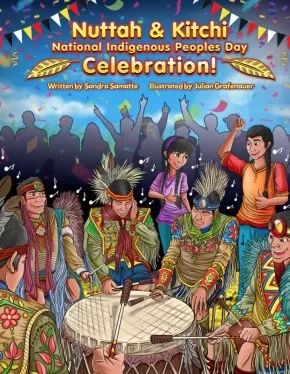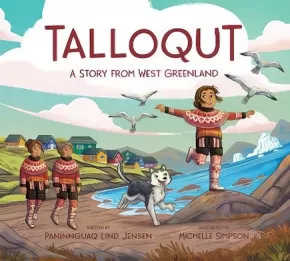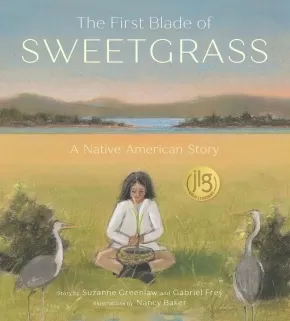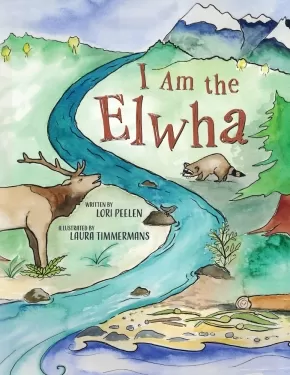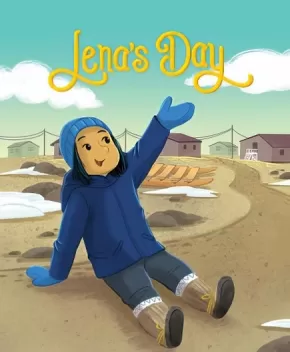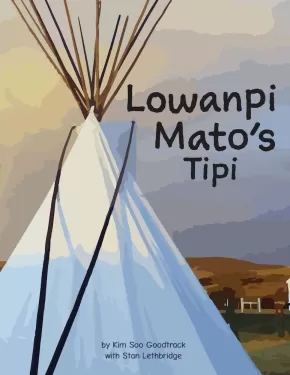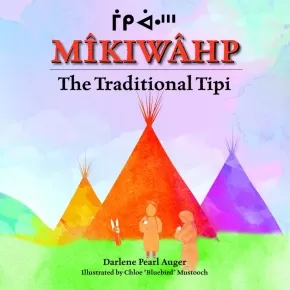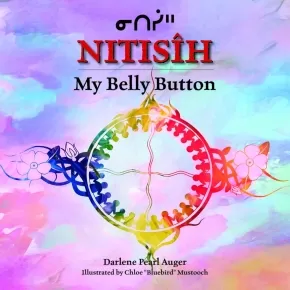
Indigenous Cultural Practices
91
-
105
of
205 Results;
Sort By
Go To
of 14
Nuttah & Kitchi National Indigenous Peoples Day Celebration
$14.99
Artists:
Format:
Paperback
Text Content Territories:
Indigenous Canadian; First Nations; Inuit; Métis;
ISBN / Barcode: 9780993937194
Synopsis:
Synopsis:
Nuttah and Kitchi National Indigenous Peoples Day Celebration is written by Sandra Samatte, Ojibwe - Saulteaux - from Skownan First Nation Treaty 2 Territory and illustrated by Julian Grafenauer, Ojibwe from Rolling River First Nation.
Come celebrate and explore with Nuttah and Kitchi on June 21st, the first day of summer as they experience all the exciting fun-filled activities and events that take place on National Indigenous Peoples Day.
Educator Information
Recommended for grades 2 to 5.
A companion activity book is available: Nuttah & Kitchi National Indigenous Peoples Day Celebration Activity Book: Indigenous Teachings and Fun Activities for Everyone
Additional Information
32 Pages | Paperback
Nuttah & Kitchi National Indigenous Peoples Day Celebration Activity Book
$9.95
Artists:
Format:
Paperback
Text Content Territories:
Indigenous Canadian; First Nations; Inuit; Métis;
ISBN / Barcode: 9781990297007
Synopsis:
Synopsis:
Companion book to Nuttah and Kitchi National Indigenous Peoples Day Celebration, featuring Indigenous Teachings and Fun Activities for Everyone!
Both resources are written by Sandra Samatte, Ojibwe - Saulteaux - from Skownan First Nation Treaty 2 Territory and illustrated by Julian Grafenauer, Ojibwe from Rolling River First Nation. Come celebrate and explore with Nuttah and Kitchi on June 21st, the first day of summer as they experience all the exciting fun-filled activities and events that take place on National Indigenous Peoples Day.
Educator Information
Recommended for grades 2 to 5.
Find the companion book here: Nuttah & Kitchi National Indigenous Peoples Day Celebration
Additional Information
32 Pages | Paperback
On the Trapline
$24.99
Artists:
Format:
Hardcover
Text Content Territories:
Indigenous Canadian; First Nations; Cree (Nehiyawak); Swampy Cree ;
ISBN / Barcode: 9780735266681
Synopsis:
Synopsis:
A picture book celebrating Indigenous culture and traditions. The Governor General Award-winning team behind When We Were Alone shares a story that honors our connections to our past and our grandfathers and fathers.
A boy and Moshom, his grandpa, take a trip together to visit a place of great meaning to Moshom. A trapline is where people hunt and live off the land, and it was where Moshom grew up. As they embark on their northern journey, the child repeatedly asks his grandfather, "Is this your trapline?" Along the way, the boy finds himself imagining what life was like two generations ago -- a life that appears to be both different from and similar to his life now. This is a heartfelt story about memory, imagination and intergenerational connection that perfectly captures the experience of a young child's wonder as he is introduced to places and stories that hold meaning for his family.
Awards
- 2021 Governor General's Literary Award for young people's literature -- illustrated books
- 2022 Shining Willow Award
- 2022 TD Canadian Children's Literature Award winner
- 2023 Chocolate Lily Award
Educator Information
Recommended for ages 4 to 8.
Shares and teaches some Swampy Cree words throughout the story.
Notes from the author and illustrator, as well as a glossary of the Swampy Cree words used in the story and a pronunciation guide are included.
This book is available in French: Ligne de trappe.
Additional Information
48 pages | 8.00" x 9.00"
Talloqut: A Story from West Greenland - Nunavummi Reading Series
$20.95
Artists:
Format:
Hardcover
Text Content Territories:
Indigenous European; Greenlandic Inuit;
ISBN / Barcode: 9781774504680
Synopsis:
Synopsis:
“Anaana, why do you have these lines on your chin?”
Arnaaleq wants to be just like her anaana, but she has a lot to learn before taking on the traditional responsibilities of a woman. Follow Arnaaleq as she grows up and works hard to master the skills to earn her own talloqut. Learn about West Greenlandic traditions in this story by tattoo artist Paninnguaq Lind Jensen.
Educator & Series Information
This book exposes children to Inuit traditions and ways of life.
This book is part of the Nunavummi Reading Series, a Nunavut-developed series that supports literacy learning while teaching readers about the people, traditions, and environment of the Canadian Arctic. This book is a level 13 book in the Nunavummi Reading Series. Nunavummi Reading Series books have also been officially levelled using the Fountas & Pinnell Text Level Gradient™ Levelling System. This book's F&P level is O.
Recommended for ages 7 to 9.
Additional Information
52 pages | 8.00" x 9.00" | Hardcover
The First Blade of Sweetgrass: A Native American Story
$24.95
Artists:
Format:
Hardcover
Text Content Territories:
Indigenous American; Native American; Abenaki (Wabanaki);
ISBN / Barcode: 9780884487609
Synopsis:
Synopsis:
In this Own Voices Native American picture book, a modern Wabanaki girl is excited to accompany her grandmother for the first time to harvest sweetgrass for basket making. She must overcome her impatience while learning to distinguish sweetgrass from other salt marsh grasses, but slowly the spirit and peace of her surroundings speak to her, and she gathers sweetgrass as her ancestors have done for centuries, leaving the first blade she sees to grow for future generations. This sweet, authentic story from a Maliseet mother and her Passamaquoddy husband includes backmatter about traditional basket making and a Wabanaki glossary.
Reviews
"Quiet text shows how careful observation and the respect of nature can provide unexpected gifts." - Kirkus Reviews
Educator Information
Recommended for ages 5 to 9.
Additional Information
32 pages | 9.00" x 10.00" | Hardcover
The Power of Style: How Fashion and Beauty Are Being Used to Reclaim Cultures
$14.95
Format:
Paperback
Text Content Territories:
Indigenous Canadian;
ISBN / Barcode: 9781773214917
Synopsis:
Synopsis:
Style is not just the clothes on our backs—it is self-expression, representation, and transformation.
As a fashion-obsessed Ojibwe teen, Christian Allaire rarely saw anyone that looked like him in the magazines or movies he sought out for inspiration. Now the Fashion and Style Writer for Vogue, he is working to change that—because clothes are never just clothes. Men’s heels are a statement of pride in the face of LGTBQ+ discrimination, while ribbon shirts honor Indigenous ancestors and keep culture alive. Allaire takes the reader through boldly designed chapters to discuss additional topics like cosplay, makeup, hijabs, and hair, probing the connections between fashion and history, culture, politics, and social justice.
Reviews
“A vibrant read about the connections between fashion, culture, and social justice.” — Kirkus Reviews, 02/23/21
“The book to appeal to a wide age range. It is important that readers of all ages be given the opportunity to learn that there are others who have had the same or similar experiences of feeling that they were different from their peers because of the way that they looked or dressed. Highly Recommended.” — CM Reviews, 02/12/21
“Dazzling and empowering . . . Fab drag queens, genderqueer and BIPOC YouTubers demoing makeup, plus-size and gender-bending cosplayers, men wearing high heels and fem fashion—they’re all here, a proud and dazzling explosion of confetti transforming the landscape.” — Booklist, *starred review, 03/02/21
Educator Information
Recommended for ages 12+
Common Core Correlations
CCSS.ELA-Literacy Strand-Reading literature:
W.6.1,1a,1b,1c,1d,1e
SL.6.1,1a,1b,1c,1d,1
RI.6.1,2,3,4,5,6,7,8
L.6.1,1a,2,2a,2b,3,3
Reading Level: Lexile 1070L
The Power of Style is a Top Ten Quick Picks for Reluctant Young Adult Readers, YALSA
Additional Information
96 pages | 8.00" x 10.00"
This Is What I've Been Told
$16.99
Artists:
Format:
Paperback
Text Content Territories:
Indigenous Canadian; First Nations; Anishinaabeg; Ojibway;
ISBN / Barcode: 9781989122693
Synopsis:
Synopsis:
Knowing our culture means knowing who we are. When we know who we are, we can walk in a good way.
It's been said when teachings are passed down from one generation to the next, good things can happen. Language is learned, knowledge is shared and culture is practiced. In this story of language preservation, author/illustrator and Anishnaabemowin language teacher Juliana Armstrong illuminates a number of Anishnaabemowin words along with their cultural connections, passed down from her Ojibway ancestors. Knowing our culture means knowing who we are. When we know who we are, we can walk in a good way.
Educator Information
Recommended for ages 6 to 8
This book shares Anishnaabemowin words, their cultural connections and how to say them, with the help of phonetics.
A story of Indigenous language preservation and revitalization.
This authentic book is written and illustrated by an Ojibway artist and Anishnaabemowin language teacher.
A teacher lesson plan is available: This Is What I've Been Told Teacher Lesson Plan
This book is available in French: C'est ce qu'on m'a dit
Additional Information
40 pages | 11.00" x 8.50"
I Am the Elwha (HC)
 $18.50
$18.50

Artists:
Format:
Hardcover
Text Content Territories:
Indigenous American; Native American; Salish; Coast Salish; Klallam (Clallam); Lower Elwha Klallam Tribe;
ISBN / Barcode: 9781771744744
Synopsis:
Synopsis:
“I am the Elwha, rushing down to the sea. I am the Elwha, wild and free.”
The Elwha River flows 72 kilometres (45 miles) from its source in the Olympic Mountains to the Strait of Juan de Fuca in the Pacific Northwest. Uniquely, it hosts all six salmon species (Pink, Chinook, Coho, Sockeye, Steelhead, and Chum) as well as several species of trout.
In 1911 two dams were built on the river. The dams blocked the migration routes of the salmon and dramatically altered the entire river ecosystem for 100 years. In 2012 the dams were decommissioned and the world’s largest dam removal and habitat restoration project began.
In this lyrical and beautifully illustrated book, the author chronicles the history of the Elwha. Narrated by the powerful voices of plants and animals that inhabit the river ecosystem, the dam builder, a worker, and the river itself, this story celebrates the ongoing rewilding of this special environment and offers a welcome to all of the creatures who are coming home.
To learn more visit: www.elwha.org
Awards
- 2021 Riverby Award for Young Readers
Reviews
“I Am the Elwha is a powerful read about a powerful river and those who value and protect it." – Raina Delisle, Hakai Magazine
Educator Information
At the back of the book are three pages of cultural, scientific, and historical information that discuss the following:
- the importance and symbolism of salmon to the Lower Elwha Klallam Tribe and other Coastal Salish Tribes
- facts about the six species of salmon found in the Elwha River (Chinook, Pink, Chum, Sockeye, Coho, and Steelhead)
- the history of the Elwha River and its status today
Keywords / Subjects: The Elwha River, Rivers, Dams, History, Environmental Awareness, Lower Elwha Klallam Tribe, Coast Salish, Native American, Culture, Washington, Animals, Salmon, First Salmon Ceremony, Plants, Nature, Settlers, Social Responsibility, Environmental Activism, Poetry.
Recommended for grades 3 to 7.
Additional Information
32 Pages | 8.5" x 11" | ISBN: 9781771744744 | Hardcover
Authenticity Note: This lyrical story, which chronicles the history of the Elwha River, is written by Lori Peelen. Robert Elofson, Tribal Elder and Harvest Manager in the Natural Resources Department for the Lower Elwha Klallam Tribes, approved Lori's work and contributed a few pages of back matter at the end of the work. Lori's story was further approved by Frances Charles, the Tribal Councilwoman for the Lower Elwha Klallam Tribe, after the entire council read and approved it.
The Canadian Content label has been applied because the illustrator of this work is Canadian.
Lena's Day - Nunavummi Reading Series
$10.95
Artists:
Format:
Paperback
Text Content Territories:
Indigenous Canadian; Inuit;
ISBN / Barcode: 9780228704843
Synopsis:
Synopsis:
Find out what Lena does on her busy day!
Follow Lena as she goes to school, plays with her friends, and spends time with her family. She learns important lessons about being responsible, honest, and respectful.
Educator & Series Information
This book is part of the Nunavummi Reading Series, a Nunavut-developed series that supports literacy learning while teaching readers about the people, traditions, and environment of the Canadian Arctic. It is a Level 12 book in the series.
Nunavummi Reading Series books have also been officially leveled using the Fountas & Pinnell Text Level Gradient™ Levelling System. F&P Level of this book: N.
Recommended for ages 7 to 9.
Additional Information
36 pages | 7.00" x 8.50" | Paperback
Lowanpi Mato’s Tipi
 $18.50
$18.50

Artists:
Format:
Hardcover
Text Content Territories:
Indigenous Canadian; First Nations; Sioux; Lakota;
ISBN / Barcode: 9781771744751
Synopsis:
Synopsis:
“Hokahe! Welcome!”
Welcome to Wood Mountain, home of the Lakota People, in southern Saskatchewan. It is here that we meet Stan Lethbridge, whose ancestral name is Lowanpi Mato (Singing Bear).
Join Lowanpi Mato as he prepares to set up his summer Tipi. He shares with us Lakota life values and traditions, and how they connect to building and taking care of a Tipi. He teaches us that to build a Tipi you need many items; some are from natural sources and others are purchased from a store. Lowanpi Mato takes us through a step-by-step building process so that we can all learn how a Tipi is built.
The Lakota language is woven throughout the story. The Lakota counting chart on pages 30 and 31 invites you to learn to count and have some fun looking back through the book to find items that match each number.
Welcome to Wood Mountain, home of the Lakota People, in southern Saskatchewan. It is here that we meet Stan Lethbridge, whose ancestral name is Lowanpi Mato (Singing Bear).
Join Lowanpi Mato as he prepares to set up his summer Tipi. He shares with us Lakota life values and traditions, and how they connect to building and taking care of a Tipi. He teaches us that to build a Tipi you need many items; some are from natural sources and others are purchased from a store. Lowanpi Mato takes us through a step-by-step building process so that we can all learn how a Tipi is built.
The Lakota language is woven throughout the story. The Lakota counting chart on pages 30 and 31 invites you to learn to count and have some fun looking back through the book to find items that match each number.
Educator Information
Lakota language is woven throughout this story, as are the seven values of Lakota life.
Lakota language is woven throughout this story, as are the seven values of Lakota life.
Includes a counting chart from 1 to 20 in Lakota, as well as a search-and-find counting game.
Additional Information
32 pages | 8.5" x 11" | Hardcover | ISBN: 9781771744751
32 pages | 8.5" x 11" | Hardcover | ISBN: 9781771744751
Mîkiwâhp: The Traditional Tipi
$9.95
Format:
Paperback
Text Content Territories:
Indigenous Canadian; First Nations; Cree (Nehiyawak);
ISBN / Barcode: 9781926696706
Synopsis:
Synopsis:
This is the story of how the Tipi is connected to the creation of life and the mother to the child. When little ones are born, they are slowly let down with a rope into the Tipi. The rope is the Spirit Mother’s umbilical cord, and the cord is the rope that ties the tipi poles together, creating a nest at the top for the baby. When the baby is born, the cord makes its journey to inside the tipi, and then the cord is used to make the baby swing. The Tipi is round like the sun, the moon, a bird's nest, berries, the drum, the Earth and a woman's belly when she is with child. There are 14 poles in a Cree Tipi that represent the 14 laws for living on the Earth. Following these laws makes us good human beings.
Educator & Series Information
Recommended for ages 6 to 12.
This book is part of the Little Women's Lodge Stories series.
Additional Information
28 pages | 6.00" x 9.00" | Paperback
Nitisîh: My Belly Button
$9.95
Format:
Paperback
Text Content Territories:
Indigenous Canadian; First Nations; Cree (Nehiyawak);
ISBN / Barcode: 9781926696676
Synopsis:
Synopsis:
This is the story of the birth of Kîstin, or “Little Tornado,” and how the baby is brought from Spirit World after choosing its Earth Mother and Father. It tells of connection of the baby’s belly button to Spirit World and to the ancestors, who speak to us through our land, our language, our songs, our ceremonies and our dreams and visions. And if the child trusts in the spirit, it will always watch out for the child.
Educator & Series Information
Recommended for ages 6 to 12.
This book is part of the Little Women's Lodge Stories series.
Additional Information
36 pages | 6.00" x 9.00" | Paperback
Powwow: A Celebration through Song and Dance (HC) (5 in Stock)
$24.95
Format:
Hardcover
Text Content Territories:
Indigenous American; Indigenous Canadian;
ISBN / Barcode: 9781459812345
Synopsis:
Synopsis:
Feel the power of the powwow dance.
Powwow is a celebration of Indigenous song and dance. It’s a journey through the history of powwow culture in North America, from its origins in colonization, the Indian Act and the Wild West shows of the late 1800s to the thriving powwow culture of today. As a lifelong competitive powwow dancer, Karen Pheasant-Neganigwane is a guide to the protocols, regalia, songs, dances and even food you can find at powwows from coast to coast, as well as the important role they play in Indigenous culture and reconciliation.
Educator & Series Information
Recommended for ages 9 to 12.
Beginning with a historical look at the origins of the powwow and then moving on to what they look like today, this book is a practical guide to the songs, dances, regalia, culture, and food associated with different powwows across North America.
This book explores how powwow culture, and an understanding of its importance in Indigenous culture, can be a part of the narrative of reconciliation.
The author is a longtime competitive powwow dancer who has travelled to powwows across North America.
This book is part of the Orca Origins series that explores cultural celebrations throughout the world.
Keywords: powwow dance, Indigenous culture, reconciliation, history, ceremonial dance.
Recommended in the Canadian Indigenous Books for Schools 2020/2021 resource list for grades 4 to 8 for English Language Arts, Social Studies, and Dance.
Additional Information
88 pages | 7.50" x 9.00" | colour illustrations / photographs
Remembering the Sun's Return - Nunavummi Reading Series
$10.95
Artists:
Format:
Paperback
Text Content Territories:
Indigenous Canadian; Inuit;
ISBN / Barcode: 9780228702894
Synopsis:
Synopsis:
Ivarluk loves listening to his anaanatsiaq's stories about long ago.
Anaanatsiaq tells Ivarluk about how they celebrated the return of the sun when she was a child and shares stories about what they did during "the great darkness."
Educator & Series Information
This book is part of the Nunavummi Reading Series, a Nunavut-developed series that supports literacy learning while teaching readers about the people, traditions, and environment of the Canadian Arctic. It is a Level 12 book in the series.
Nunavummi Reading Series books have also been officially levelled using the Fountas & Pinnell Text Level Gradient™ Levelling System. F&P Level of this book: O.
Recommended for ages 7 to 9.
Additional Information
24 pages | 9" x 8"
Siha Tooskin Knows the Catcher of Dreams
$11.95
Format:
Paperback
Text Content Territories:
Indigenous Canadian; First Nations; Stoney-Nakoda (Nakota);
ISBN / Barcode: 9781553798323
Synopsis:
Synopsis:
Siha Tooskin (Paul) takes his expert bike riding to a whole new level to make sure he doesn't miss a thing. At home, Mugoshin (Grandmother) is creating a very special gift to protect the precious little one. Join Paul as he enjoys delicious bannock, imagines the future of a new baby sister, and listens to Mugoshin’s teachings about the catcher of dreams.
The Siha Tooskin Knows series uses vivid narratives and dazzling illustrations in contemporary settings to share stories about an 11-year-old Nakota boy.
Reviews
"Siha Tooskin Knows the Catcher of Dreams is one in a series of Siha Tooskin Knows books that follows the life of Siha Tooskin, a young Indigenous boy (who also has the English name Paul). In this book Siha Tooskin’s mother is about to give birth to another baby so Siha Tooskin’s grandparents come to stay with him. His grandmother begins to tell him the story of the dream catcher along with the importance of this often-commercialized object. I love the sense of family we get from this book and how much importance Siha Tooskin’s grandmother places on the family unit, especially in a time where many Indigenous families are still actively being destroyed by systemic inequalities. As a teacher, I appreciated the mention of the Truth and Reconciliation Commission and the way teachers are still learning how to accurately represent Indigenous peoples. The illustrations are beautiful (especially the full page ones) and the grade level for reading is somewhere around grades 3-5 but the content is also perfect for grades 7 & 8 history. Overall, a great read perfect for K-8 classrooms alike." — Alyssa Gray-Tyghter, NetGalley, November 2019
Educator & Series Information
The Siha Tooskin Knows series uses vivid narratives and dazzling illustrations in contemporary settings to share stories about an 11-year-old Nakota boy. Explore Nakota culture and traditions alongside Paul Wahasaypa and his community in this eight-book series.
Key Features:
- A coming-of-age story about a Nakota boy learning about his identity and developing a sense of cultural responsibility in a contemporary, urban setting. Also touches on issues of environmental ecology and bullying.
- Charlene Bearhead and Wilson Bearhead are both well-respected and accomplished educators and storytellers.
- A part of the Siha Tooskin Knows series with teachings that show an Indigenous community and family in a positive light.
- Nakota lessons aim for universality, informing both Indigenous and non-Indigenous readers.
- This book illustrates how traditional teachings can play a vital role in contemporary life.
- Dynamic illustrations by Nakota artist Chloe Bluebird Mustooch bring this story to life.
Recommended for ages 9 to 11. Early Chapter Books.
Recommended in the Canadian Indigenous Books for Schools 2020/2021 resource list for Grades 3 to 6 in the areas of English and Social Studies.
Subjects/Themes/Keywords: Dreamcatcher, Nakota, Family.
Includes a glossary for the Nakota terminology in the story. Words are written phonetically as Nakota is not a written language.
Additional Information
32 pages | 5.50" x 8.00"
Sort By
Go To
of 14

